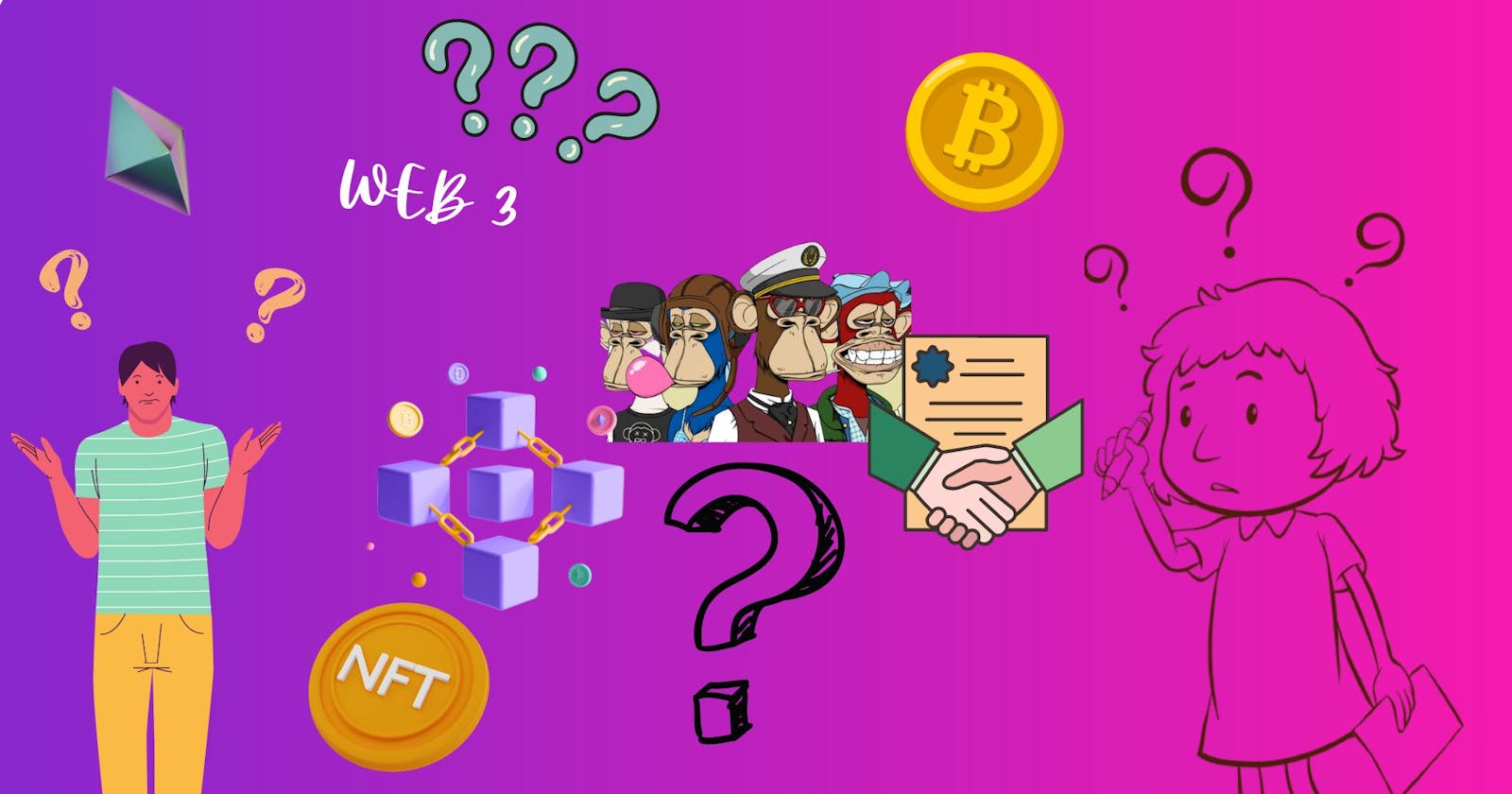Hi there 🖐🏽, Are you new in web3 and have some questions regarding this fast growing space ?.
Most if not all people new into this web3 space seem overwhelmed at first and do not know how to go about it and have tons of questions flooding in about its nature and how it works, but hey I can help with that 😉.
I would be giving answers to some web3 questions commonly asked by beginners (I also asked these myself included lol 😂) and things you need to know . LFG 🚀🚀
QUESTION 1
What is Web3 , Ethereum and the Blockchain I've been seeing it around lately and its really confusing. 😕
As a baby 👶🏽 needs to crawl before walking you also need to know this before you can be fully knowledgeable about this space.
Q1-1
What is web3 all about is a pretty common question I get asked and I say this:
To understand something you have to look at it's origin. Therefore to understand Web3 you look at its predecessors..🧓
Predecessors as in (Web1 & web2) and giving a brief answer for each of the predecessor aka iterations of the web.
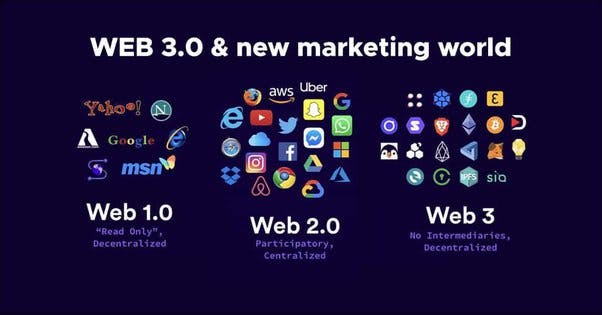
Web 1: This was known as the read-only era (1990's). Here marked the birth of web and came with the invention of static web pages using technologies like HTML. Users were only able to read and view content created by developers as then content creators were more or less developers
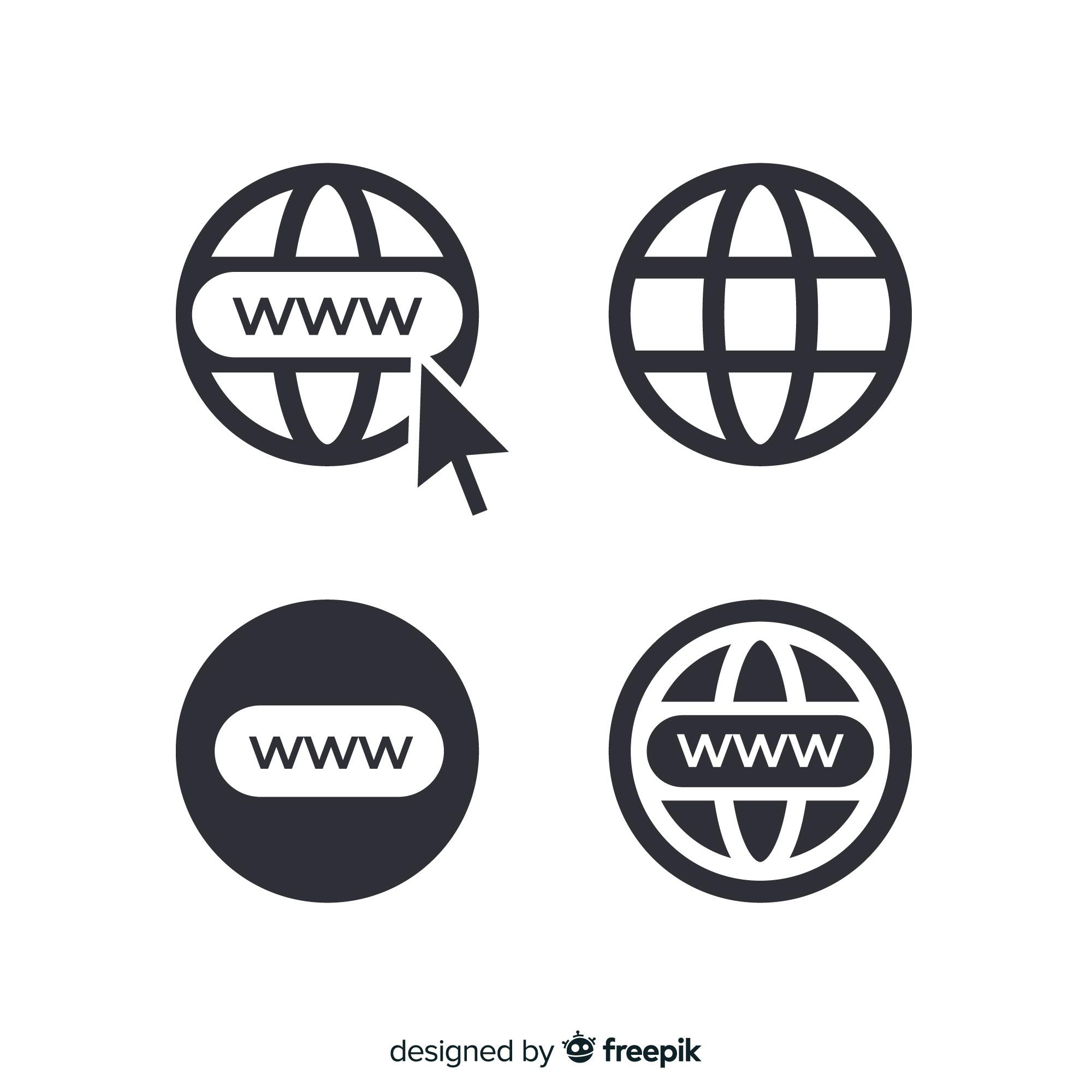
Features of Web1
- static and personal websites
- data stores website servers
- programming knowledge to be a content creator.
Web 2 This is known as the read and write Web era were not only developers but users were able to create content. Static Web pages soon turn into dynamic ones using technologies like; HTML5, CSS3, JS, ANGULAR.JS , REACT.JS . It was also referred to as the social-media era.
Here interactions with the Web massively increased as applications for content creating was a thing. Blog post, YouTube videos, social-media presence etc.
Features of web 2
- centralization: big companies like Facebook, YouTube, Google, Twitter. were ( or should I say are ) in control of users data and ownership of their content.
- consent is needed for putting anything online.
- profit made goes directly to them and small percentage to the creators.
WEB 3 This marks the new era of web evolution and its sometimes referred to as the Semantic Web. This marks the birth of blockchain technologies , crypto currencies, Fungible and Non-fungible tokens, open source technologies, DECENTRALISATION.
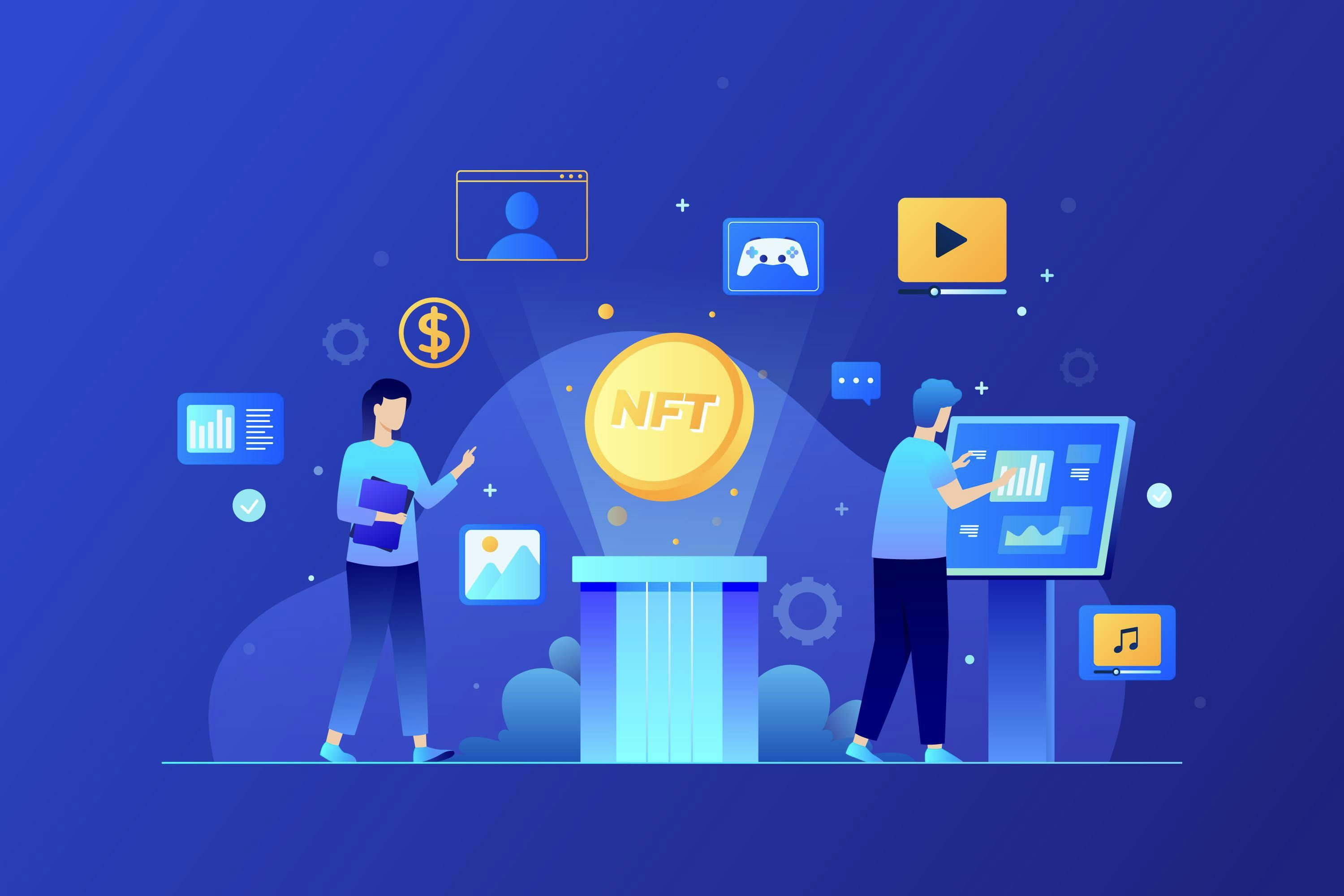
Web 3 brings about a permission-less and trust less system where users have ownership to their creations, data storage is upgraded with the peer to peer network of nodes blockchain technology. Creation of both fungible and non fungible tokens.
The tokens solve the problem of payment of different currencies across the Web and more. DAOs--> Decentralized Organizations Where there is no central power as the community make decisions on rules voted upon. dApps, EVM (Ethereum Virtual Machine), Defi, etc.
I've merely told you a bit of the whole in the above answer .
Q1-2

Ethereum is a decentralized , open-source blockchain with smart contract functionality => by Wikipedia
- Decentralized ( not centralized ) i.e no central leader, as Ethereum is not controlled by anyone.
- open-source as in generally available to anyone and everyone and its open to redesign and public accessibility.
So Ethereum can be said to be a distributed ledger containing transactions which isn't controlled by a single party and it source code can be publicly accessed.
It is also has a currency called ether (eth) used to send and receive value, update the blockchain using transactions.
Q1-3
The Blockchain: this can be said to be a distributed database that is shared among the nodes over an entire network of computer systems. The blockchain can be said to be like a regular database but with more scalability, transparency and security.
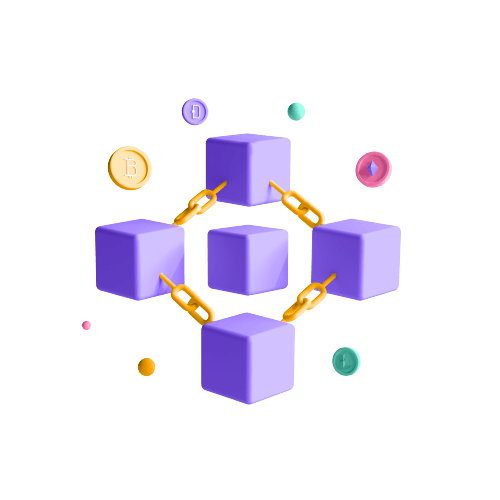
The blockchain store transactions into somethings we call blocks which have a specific capacity and when maxed out, the storage goes to a next block and each block has a reference to the previous block there by forming a chain of blocks and the first block is usually called the genesis block.
QUESTION 2
Do I have to learn and know Web1 then web 2 before now learning and understanding web3?? I'm lost.
Think of this as watching a series and starting from the season 3 or the latest season, you may understand what's the series is about but its better to watch from season 1 to get the whole message.

So to answer this question you don't really need to know about them before getting web 3. But for more understanding of web3, then knowledge of the web iterations is great. Becoming a web3 developer? Then you'll need knowledge about web2.
QUESTION 3
ERC20, ERC721, ERC1155 why are they all of Ethereum? Aren't there any other?
The ERC (Ethereum Request for Comment) implementations are the standard for creating smart contracts on the Ethereum blockchain and as almost all tokens are created under the Ethereum blockchain.
Other tokens under the Ethereum blockchain follow the ERC convention. But another blockchain like Solana doesn't use the erc20 contracts but the Solana program Library (SPL) to create tokens.
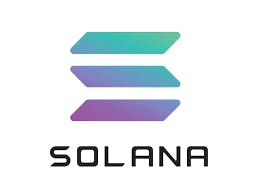
And for more understanding :
- ERC 20 = Fungible Tokens
- ERC721 = Non-fungible tokens
- ERC1155 = Multi Token
QUESTION 4
What is the difference between ETH 2.0 and Layer 2
Layer 2 is a separate blockchain that extends Ethereum. They are solutions for scalability, increased throughput and reduced gas fees of the Ethereum Mainnet. Polygon is a good example of the layer 2 solution.
Eth 2.0 ( aka Serenity) is an upgrade to the Ethereum blockchain. The upgrade is not off-chain as its an upgrade on the Mainnet. Hope to improve scalability, reduce gas fees , improve security and maintaining decentralization. It is proposed to be released soon .
QUESTION 4
I understand web3 now and I would like to start in this space, so how do I start?
This depends on the career path you wanna choose in the space. But looking at a developers perspective you would need a roadmap on how to get started and this is a link to one by Idris Olubisi.
QUESTION 5
Am I late and when do I start learning?
That's a simple question.....start ### NOW!!!!!! you're still early.
QUESTION 6
What's the deal with a Nfts and why do they cost sooo much, cos aren't they like just JPEGS?
An Nft stands for NON-FUNGIBLE TOKEN, as in a token that's unique from others. Not like fungible ones the regular tokens you and I know like bitcoin, ether, Matic , DodgeCoin etc they are not unique in the sense that many people can have many amount of bitcoins or ether or Dodgecoin but in the case of NFTs you can only have one Type like the Bored Ape #5537 owned by only UMG (Universal Music Group )

Yes, anyone can have a picture of the nft but that doesn't mean they own it, the ownership of an nft is recorded and can be verified on the blockchain. Just like having a picture of the Mona Lisa doesn't mean I'm the owner.
By the way, Nfts aren't just arts or drawings that can also be real estate, music, collectibles etc.
QUESTION 7
What other career aspect or fields are present in web3, cos I can't code
Well there are varieties of others things to do in Web3 aside programming/developing smart contracts
- Technical writers
- Graphics designers
- Community Manager
- Public relations
- Marketing
- Defi Analyst etc
QUESTION 8
I wanna build in web3 . Do I start with solidity? If not what then?
This depends on the path you choose whether to become a full Stack web3 developer, then you'll need not only solidity but some other languages and it also depends on your programming background and experience.
If you were a web developer and confident in your skills before coming into this space then it's alright to start solidity. But if your only interested in making smart contracts then you should learn solidity programming language, but it is advisable to learn others.
As a Fullstack web3 developer you would (may) need to know the following :
- HTML, CSS and JS
- React js (Next js)
- Solidity / Rust
- Bootstrap / Tailwind css
- node js
QUESTION 9 (Last question)
What is the .eth suffix that some developers and people in web3 have on their names on some social media platform (eg :twitter)?
Those names ending in '.eth' are called ENS domains.
There are lots of people who use their ENS domains on their social media, mostly their nickname and then ending with '.eth' .

They are called ENS domains because they are used to just identify a particular Ethereum address, so instead of the long 0xBla12Bla34Bla we know, we now get a more readable name ending in .eth and costing a particular amount of fee and these domains can be sent ethers or Nfts like the way regular addresses work.
This is the end of the article and I hope I answered some of your unanswered questions you had about web3 and this fast growing space. 🤗😎.
